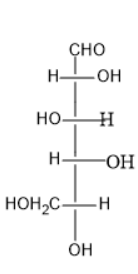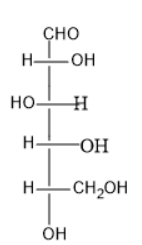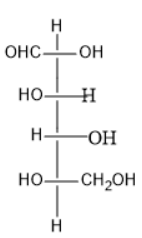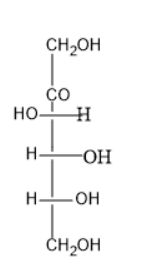Answer
338.4k+ views
Hint: Carbohydrates are sugar molecules that have asymmetric carbons and are classified into D and L configurations.
D configuration can be given to sugars containing hydroxyl groups right to the farthest asymmetric carbon from the carbonyl group.
L configuration can be given to sugars containing hydroxyl groups left to the farthest asymmetric carbon from the carbonyl group.
Complete answer: Carbohydrates are sugar molecules consisting of mainly carbon, hydrogen and oxygen atoms.
These are also called hydrates of carbon.
The general empirical formula of carbohydrates is \[{C_m}{\left( {{H_2}O} \right)_n}\]
The oxygen and hydrogen are in the ratio of 1:2 in the carbohydrates.
Carbohydrates contain carboxyl and hydroxyl groups.
Based on the hydroxyl group, these sugars are classified into D and L sugars.
The sugar molecule with the asymmetric carbon farther from the carbonyl group contains the hydroxyl group at the left side; it can be called L sugar.
The sugar molecule with the asymmetric carbon farther from the carbonyl group contains the hydroxyl group at the right side; it can be called L sugar.
In the given options,
Option (A) contains five carbon atoms; the last carbon is farther from the carbonyl group than the hydroxyl group at the left side.
Thus, it is L sugar.
Option (B) contains five carbon atoms; the last carbon is farther from the carbonyl group than the hydroxyl group at right side.
Thus, it is D sugar.
Option (C) contains five carbon atoms; the last carbon is farther from the carbonyl group and contains the hydroxyl group at both right and left side.
Thus, it is neither L nor D sugar.
Option (D) contains five carbon atoms; the last carbon is farther from the carbonyl group than the hydroxyl group at right side.
Thus, it is D sugar.
Thus, option A is L-sugar.
Note:
The configuration must be written by considering the farthest carbon from the carbonyl group.
Though the nearest carbons contain hydroxyl groups, they should not be considered.
The direction of the hydroxyl group to the last farther carbon from the carbonyl group must be clearly noticed.
D configuration can be given to sugars containing hydroxyl groups right to the farthest asymmetric carbon from the carbonyl group.
L configuration can be given to sugars containing hydroxyl groups left to the farthest asymmetric carbon from the carbonyl group.
Complete answer: Carbohydrates are sugar molecules consisting of mainly carbon, hydrogen and oxygen atoms.
These are also called hydrates of carbon.
The general empirical formula of carbohydrates is \[{C_m}{\left( {{H_2}O} \right)_n}\]
The oxygen and hydrogen are in the ratio of 1:2 in the carbohydrates.
Carbohydrates contain carboxyl and hydroxyl groups.
Based on the hydroxyl group, these sugars are classified into D and L sugars.
The sugar molecule with the asymmetric carbon farther from the carbonyl group contains the hydroxyl group at the left side; it can be called L sugar.
The sugar molecule with the asymmetric carbon farther from the carbonyl group contains the hydroxyl group at the right side; it can be called L sugar.
In the given options,
Option (A) contains five carbon atoms; the last carbon is farther from the carbonyl group than the hydroxyl group at the left side.
Thus, it is L sugar.
Option (B) contains five carbon atoms; the last carbon is farther from the carbonyl group than the hydroxyl group at right side.
Thus, it is D sugar.
Option (C) contains five carbon atoms; the last carbon is farther from the carbonyl group and contains the hydroxyl group at both right and left side.
Thus, it is neither L nor D sugar.
Option (D) contains five carbon atoms; the last carbon is farther from the carbonyl group than the hydroxyl group at right side.
Thus, it is D sugar.
Thus, option A is L-sugar.
Note:
The configuration must be written by considering the farthest carbon from the carbonyl group.
Though the nearest carbons contain hydroxyl groups, they should not be considered.
The direction of the hydroxyl group to the last farther carbon from the carbonyl group must be clearly noticed.
Recently Updated Pages
What are the figures of speech in the poem Wind class 11 english CBSE

Write down 5 differences between Ntype and Ptype s class 11 physics CBSE

Two tankers contain 850 litres and 680 litres of petrol class 10 maths CBSE

What happens when eggshell is added to nitric acid class 12 chemistry CBSE

Why was Kamaraj called as Kingmaker class 10 social studies CBSE

What makes elections in India democratic class 11 social science CBSE

Trending doubts
What is 1 divided by 0 class 8 maths CBSE

Which are the Top 10 Largest Countries of the World?

Give 10 examples for herbs , shrubs , climbers , creepers

Differentiate between homogeneous and heterogeneous class 12 chemistry CBSE

Difference between Prokaryotic cell and Eukaryotic class 11 biology CBSE

Fill the blanks with the suitable prepositions 1 The class 9 english CBSE

The Equation xxx + 2 is Satisfied when x is Equal to Class 10 Maths

10 examples of evaporation in daily life with explanations

Write a letter to the principal requesting him to grant class 10 english CBSE







